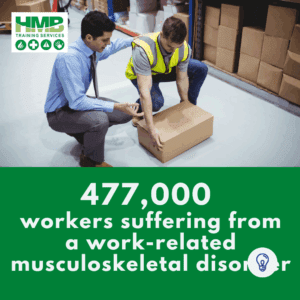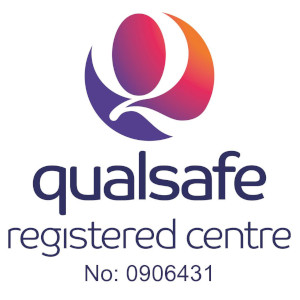Whether moving boxes in a warehouse, assisting patients in care settings, or handling deliveries, manual handling is part of everyday working life for many people. But doing it incorrectly can lead to serious injuries, especially to your back. That’s why “Lift Smart: Manual Handling That Keeps You Safe” isn’t just a catchy phrase; it’s a vital approach to protecting your health and well-being. Back injuries are one of the most common causes of long-term absence from work, and most are entirely preventable.
In this blog, we’ll walk you through the basics of safe manual handling, explain why technique matters, and show you how a few simple adjustments can make a huge difference to your health, safety, and productivity. If you or your team regularly lift, carry, push, or pull loads, this is essential reading to keep everyone protected and injury-free.
What Is Manual Handling?
Manual handling refers to any activity that requires you to lift, carry, push, pull, or move a load by hand or bodily force. It’s something many of us do every day, often without thinking about the risks involved.
Common tasks that involve manual handling include:
-
Lifting and carrying boxes, equipment, or materials
-
Pushing or pulling carts, trolleys, or wheelchairs
-
Moving furniture or heavy appliances
-
Loading and unloading goods from vehicles
-
Stacking or arranging items on shelves or pallets
-
Assisting or supporting people, such as helping a patient to stand or move
-
Handling tools or machinery that require physical effort
-
Collecting and disposing of waste or recycling bins
Understanding these everyday tasks helps highlight why safe manual handling is essential to prevent injury.
The Cost of Getting It Wrong
Manual handling may seem straightforward, but getting it wrong can have serious, long-lasting consequences; especially for your back. Poor technique or ignoring safety precautions can lead to injuries such as muscle strains, slipped discs, and chronic back pain.
for your back. Poor technique or ignoring safety precautions can lead to injuries such as muscle strains, slipped discs, and chronic back pain.
Consider this: a single incorrect lift can result in a lifetime of pain and disability. According to the Health and Safety Executive (HSE), musculoskeletal disorders (MSDs), including those caused by manual handling, account for nearly 30% of all workplace injuries in the UK. Back injuries alone lead to millions of lost working days every year.
For individuals, the impact is physical pain, reduced mobility, and potentially long periods away from work or even permanent disability. This can affect your quality of life both at work and at home.
For employers, the consequences are equally significant. Injuries result in lost productivity, increased sick leave, and often costly compensation claims. Moreover, a workplace with frequent injuries risks damaging staff morale and reputation.
Investing time and resources in proper manual handling training isn’t just about compliance—it’s about protecting people’s health and safeguarding your business.
The Basics of Safe Manual Handling: Tips to Keep You Injury-Free
Proper technique and awareness can make all the difference when it comes to manual handling. Follow these key safety tips to protect your back and avoid injuries:
1. Plan Your Lift
Before you lift or move anything, take a moment to assess the load and your environment. Ask yourself:
-
Is the load too heavy or bulky for me to handle alone?
-
Are there any obstacles or slippery surfaces in my path?
-
Can I use mechanical aids like trolleys or hoists instead?
2. Use Mechanical Aids Whenever Possible
Tools like dollies, forklifts, or conveyor belts reduce the physical strain and lower the risk of injury. Don’t hesitate to use them if they’re available.
3. Maintain a Good Posture
How you position your body during lifting is crucial:
-
Keep your back straight, and avoid bending or twisting.
-
Bend your knees and squat down to the load, using your leg muscles to lift—not your back.
-
Keep the load as close to your body as possible.
4. Lift Smoothly and Avoid Jerky Movements
Lift steadily, without sudden twists or jerks, which can strain your muscles and ligaments.
5. Communicate and Get Help When Needed
If a load is heavy or awkward, ask for help. Team lifting is safer and more effective.
6. Take Regular Breaks and Don’t Rush
Fatigue increases the chance of accidents. Pace yourself and rest to maintain strength and concentration.
Following these safety principles not only protects your health but also contributes to a safer, more productive workplace.
Training Makes the Difference
Proper manual handling training equips you and your team with the knowledge and skills needed to reduce the risk of injury. Through practical demonstrations and hands-on practice, you’ll learn how to assess loads, plan lifts, and use the correct techniques every time.
Training also raises awareness of workplace risks and legal responsibilities. Under the Manual Handling Operations Regulations 1992, employers must provide adequate training and ensure safe handling practices are followed. This not only helps protect employees but also keeps your business compliant with health and safety laws.
Our tailored manual handling courses focus on real-world scenarios relevant to your workplace, ensuring everyone feels confident and competent when moving loads. Investing in training means fewer injuries, less downtime, and a safer, more productive work environment.
Conclusion
Manual handling may be a routine task, but it carries real risks if done incorrectly. By understanding the basics, planning your lifts, and using safe techniques, you can protect your back and avoid serious injury.
Remember, safety starts with knowledge and practice — Lift Smart: Manual Handling That Keeps You Safe. Take the first step today by getting trained, and ensure you and your team stay healthy, safe, and productive for years to come.
Further Training – Lift Smart: Manual Handling That Keeps You Safe
Our Manual Handling Level 2 course is designed for those who regularly lift, carry, push, or pull heavier or more complex loads at work. Building on basic principles, this course provides in-depth training on safe techniques, risk assessment, and how to minimize the risk of injury. With practical, hands-on sessions and clear guidance on legal responsibilities, this course empowers you and your team to work safely and confidently. Perfect for supervisors, team leaders, and employees looking to enhance their manual handling skills and promote a safer workplace.
complex loads at work. Building on basic principles, this course provides in-depth training on safe techniques, risk assessment, and how to minimize the risk of injury. With practical, hands-on sessions and clear guidance on legal responsibilities, this course empowers you and your team to work safely and confidently. Perfect for supervisors, team leaders, and employees looking to enhance their manual handling skills and promote a safer workplace.
Our manual handling and health and safety courses give you the confidence and knowledge to handle physical tasks safely, reducing the risk of injury to yourself and others. You’ll learn how to assess risks, use correct techniques, and apply best practices in the workplace. Whether you’re helping a colleague move heavy equipment or managing a busy environment, you’ll have the skills to work safely and avoid common accidents. Don’t wait until an injury happens—be proactive and get trained in manual handling and health and safety today!
Learn more here on our Manual Handling Training



